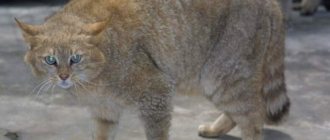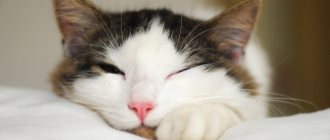Origin story
The first mention of big-eyed cats with velvet gray skin was noted in 1860.
But not in Russia, as you might think, but in England. The individuals were taken from Arkhangelsk on board a ship, and, once in Foggy Albion, they quickly became popular, standing out from other cats with their unusual appearance and ability to catch rats and mice. In the memoirs of Queen Victoria, numerous representatives of this breed are mentioned more than once, snooping around the palace back and forth. A popular British breeder, having fallen in love with the breed, decided to start strengthening it, and for this she began to attract new forces for this: she brought several purebred individuals from Arkhangelsk and a couple of similar ones from Norway.
After the first exhibition, a breed standard was developed, and the eye color was initially indicated as yellow, not green (green appeared only in 1928).
The Second World War not only claimed millions of lives, but also practically destroyed the breed. Enthusiastic breeders from Finland, Sweden, Britain, and Denmark began to restore it. But - here's the problem! – there were so few purebred individuals that we had to look for and bring other cats from all over the world that had a similar color and structure. Both British and Siamese cats took part in the process.
It soon became clear that such crossings were not beneficial: the resulting individuals had not only bad character, but also serious genetic disorders. This confused the English breeders so much that they stopped their research, but the American ones continued to experiment, and the American branch of the blue Russian breed was born.
In Russia, foreign animals were crossed with cats similar in physical characteristics and character. Among them there were often outbred ones. This benefited the breed and beautiful, strong kittens began to appear, who got along with people without problems and did not suffer from serious illnesses.
At what price can you buy a kitten?
A young individual with the appropriate documents can be purchased within the price range from 150 to 800 dollars. The price is affected by the class and health of the animal. Most often, females have a higher price than males. See also all photos and names of breeds - purebred cats.
Popular kennels for this breed:
- Russia - (your nursery is here);
- Belarus - (take place);
- Ukraine - (submit an application).
Standards
The Russian Blue cat gives the impression of being a sophisticated creature, full of grace, with graceful posture.
| Standard | Description |
| Head | Wedge-shaped, with a flat forehead and straight nose, rounded chin and convex whisker pads. |
| Mustache | Long and straight, nose blue-gray. |
| Eyes | Oval in shape, widely spaced. The iris is colored bright green. |
| Ears | Large, inclined forward, slightly drooping. The tips can be either sharp (American standard) or rounded (European standard). |
| Torso | Elongated, with well-developed muscles, small but strong. The neck is long, the limbs are straight and slender. The paws are oval in shape, the paw pads are elastic, soft to the touch, light pink. |
| Tail | Long, smooth, its tip is rounded. |
| Wool | The fur is soft and very thick, growing evenly. |
Today, there are 3 appearance standards: American (large and forked ears, bright blue coat color), European (thick, uniform coat with a silver tint) and English (wedge-shaped head and silvering on the fur).
Defects:
- Stains on the skin.
- Aggressive, unsociable character.
- No claws.
- Strabismus.
- The coat is too tight to the body.
- Closely spaced eyes, bulging or too deep-set.
- Malocclusion.
- Tail with kinks or loops.
Weight table by month
In general, the body size of the Russian Blue is average, this affects the weight of the pets.
| Age | Female (kg) | Male (kg) |
| newborn | 0.065-0.145 | 0.070-0.150 |
| 1 month | 0.260-.0.630 | 0.550-0.750 |
| 2 | 0.460-0.920 | 0.9-1.5 |
| 3 | 1-1.5 | 1.5-2.5 |
| 4 | 1.6-2.6 | 1.7-3.7 |
| 5 | 2-3 | 2-4.2 |
| 6 | 2.2-3.6 | 2.3-4.9 |
| 8 | 2.4-4.2 | 2.6-5.3 |
| 10 | 2.5-4.3 | 2.8-5.5 |
| 1 year | 2.6-4.5 | 3.2-5.7 |
| 2 years + | 2.7-4.7 | 3.3-6.2 |
| Sterilized weight | 2.7-5.1 | 3.6-.6.6 |
Colors
The color of the Russian Blue cat is smoky gray with a light silver tipping (according to the WCF standard) and bluish with the same silver tipping.
In the photo there is a cat of the Russian Blue breed, blue and gray in color.
The Russian Blue's coat can change color. This depends on several factors: for example, if the cat spends a lot of time basking in the sun, sleeps close to heating devices, and also does not eat properly (if there is an excess of copper and iron in the food).
Purchasing a Russian Blue kitten
Pet lovers can look for a baby Russian Blue cat for themselves (to raise and care for). And beginners and professional breeders are looking for such kittens for breeding. Experienced cat breeders often know the standards, but amateurs may not understand the characteristics of the breed. Therefore, before you start searching for a kitten, you need to familiarize yourself with the basic criteria by which you can make the right choice. It is very important not to make a mistake, since a purebred animal cannot be cheap. But the price may also depend on the prestige of the nursery.
If you want a purebred kitten, then look for nurseries on Avito, then look on the Internet for everything about these specific nurseries, exclude those that have bad reviews, then call and go to choose a kitten.
VASY, forum user
https://forum.auto.ru/brothers/440561/
Criterias of choice
There are several main criteria for choosing a cat:
- Nursery conditions.
- Appearance of a kitten.
- Appearance of the kitten's parents.
- Documentation.
to buy a purebred cat, and not a simple gray kitten, you need to be guided by a number of rules
The nursery should be clean and there should be no foreign odors. Kittens offered must look neat and well-groomed. If any wounds, dull fur, etc. are obvious on the baby, then perhaps he was not kept properly. In addition, you need to pay attention to the characteristics of the breed. There should be no white or black spots in the baby's color (even white paws are unacceptable). The base coat may appear slightly striped, but this is not critical as the residual tabby will subside over time. The kitten's tail should be flexible and soft (there should be no kinks). In addition, pay attention to the color of the hairs. The very edge of the hair should be “silver” (silvering). This trait in the color of blue cats appears in kittens from 3 months and persists throughout their lives. The cat's eyes should be green (but not yellow). The kitten must also behave actively (playfulness, jumping ability, etc.).
The Russian Blue cat kitten is friendly and calm. The animal should not “shy away” when new people appear. And even more so, the kitten should not scratch, bite or growl.
If it is important for you to know what the kitten will be like when it grows up, ask the breeder to show its parents. A healthy kitten will only be born to a healthy cat, which means the baby’s mother should also look good. And also the mother must have veterinary documents (make sure she has been vaccinated). If the breeder says that the kitten or its parents have some kind of title (or award), ask for supporting documents (for example, a diploma of participation in an exhibition). In addition, if one of the cat’s parents has a pedigree, then a conscientious breeder will offer to familiarize himself with it (if a kitten is purchased, a copy of the pedigree must be handed over). And the breeder must also enter into an agreement with you, which will indicate the rights and obligations of the new owner (the need for castration, participation in breeding work, terms of purchase and sale, etc.).
If the kitten you like has yellow eyes, but the breeder assures you that this will go away, then you are being deceived
At what age can you adopt a kitten?
A conscientious breeder should not sell/give away kittens before three months of age. If a nursery gives away a kitten under this age, it means the owner of the nursery wants to save money on its maintenance. The need to get three months is due to a number of reasons:
- vaccinations;
- immunity;
- socialization.
Each kitten must be accompanied by a veterinary passport with vaccinations. Basic mandatory vaccinations are given up to 12 weeks. In addition, if the kitten you like is suitable in age, the breeder must provide contact information for the veterinarian who administered these vaccinations. Another important reason for this rule is immunity. The fact is that early weaning of a kitten from its mother can lead to negative consequences. With cat's milk, the baby receives primary immunity. If the kitten is fed other foods too early, digestive tract problems may occur.
The cat also teaches its cub some skills: going to the litter box, licking itself, playing, etc. Weaning a kitten early will lead to the development of a problematic character.
It is not recommended to adopt a kitten under 3 months old
Character and behavior
Nature generously endowed the Russian Blue cat not only with good appearance, but also with extraordinary dexterity. All the flies, mice and other small living creatures that have bothered you for so long will disappear literally within a few days after this graceful, light-eyed predator takes up residence in your house. Moreover, she clearly divides animals into “us” and “strangers”: hamsters and birds that grew up side by side with her are under her protection, but strangers are definitely not welcome!
Other cats are not enemies for her, but not friends either. It would be more correct to call them simply roommates, whom the Russian Blue graciously tolerates. But conflicts often arise with dogs.
The Russian Blue has a warmer attitude towards her family, but even here she clearly divides everyone into categories: one is the leader, who is allowed a lot, the rest are service personnel, from whom you can demand food and entertainment. He does not like strangers, prefers to hide and watch them from afar.
He treats small children with caution, but carefully, not allowing himself to show aggression towards them without a reason. But if the child crosses the line - for example, causes her severe pain - he will become angry and may hit with his paw or hiss threateningly. Keep this in mind when planning to bring a cat of this breed into your home.
And in everything else, as in the famous song: everything is fine, beautiful marquise! The smoky beauty will get along well both in a large spacious house and in a small apartment; she will feel comfortable both in a large family and with just one person. The ability to listen is a quality that is noticed by everyone who is more or less familiar with this breed. They carefully monitor the cleanliness of their skin and paws, eat carefully and never allow themselves to rush around the house, destroying everything in their path.
They are difficult to train, but they are very smart and understand perfectly well what is wanted from them at one time or another. Active and playful, but in moderation.
Periods of activity are followed by periods of relaxation when the cat needs to be alone. At such moments, they prefer to hide from prying eyes somewhere further away and higher. It would be right to buy your pet a special house on a high stand, where she can go when necessary.
How to choose the right kitten
It is advisable to buy a Russian Blue from a specialized nursery or from a trusted breeder with an impeccable reputation. At the time of sale, the baby must have a veterinary passport with vaccination marks and a metric confirming its breed.
The three-month-old blue kitten has green eyes, a straight tail without kinks and fur with traces of silvering. The physical health of the baby can be judged by a soft belly, clear eyes and clean skin without scratching or redness.
Kitten care
Caring for a kitten of this breed is not as difficult as it seems at first glance. Usually, by the time the kitten is weaned from its mother and moves to a new home, it is already accustomed to the litter box and knows the scratching post. Therefore, new owners can only show the pet where its toilet, place to sleep and bowls of food are located.
To ensure safety, all wires, household chemicals and small objects that the kitten might mistake for a toy are hidden from the kitten. And to make caring for the animal easier, they purchase in advance:
- scratching post;
- tray and filler;
- bowls for food and water;
- house or bed;
- toys;
- carrying bag;
- hygiene products;
- grooming tools.
Care instructions
Caring for this breed is easy and pleasant. It is enough to brush it just once a week with a regular soft brush for fur, and bathe it when it gets dirty.
Bathing
If your pet often runs around the garden and hunts, naturally, you need to wash it more often, but if it sits at home, it will be enough to wash the cat once every 4 months. For bathing, choose a special product, because your human shampoo will not suit her. It contains too many components that irritate the skin, and if you do not wash it off from the fur well and the cat swallows the gel while licking itself, then it will get a severe stomach upset.
Does your cat like to swim?
Not really
Ears
The cat's ears are cleaned every week by wiping the inside of the shell with a damp cotton swab. Do not pour anything inside, even if they are very dirty.
Claws
To protect your environment from the claws of the Russian Blue, buy a scratching post, and it’s better not just one, but several. Place them in all rooms and teach the animal to sharpen its claws only there. If you take up this issue while the animal is still small, you will not have problems in the future, but as the cat ages, it becomes more and more stubborn and the task becomes much more difficult.
Eyes
The Russian Blue's eyes do not leak, but check them occasionally, and if you find pus or mucus in the corners, take your pet to the veterinarian. If dirt gets into the eyes and the cat rubs them with its paw, wipe them with a cotton pad soaked in boiled warm water or chlorhexidine.
Toilet
The Russian Blue carefully monitors the cleanliness of the tray and woe to you if you forget to remove cat feces on time or do not rinse the container well.
Having smelled an unpleasant smell, the cat will shamelessly choose another place for its toilet chores: for example, a rug in the bathroom. And if the situation repeats, the cat will not be afraid to pee on your bed as a sign of revenge.
Expert opinion
Dusheba Vera Ivanovna
In 2010, she graduated from the Moscow State Academy of Veterinary Medicine named after K.I. Scriabin with honors, specializing in veterinary medicine. I regularly attend veterinary conferences, congresses, and webinars.
Sometimes a puddle on the floor speaks of something completely different: males thus give a sign that they are “ripe” and are waiting for a female. There are two ways to solve this problem: either find a girlfriend for the cat, or castrate him. It is better not to give drugs to suppress the hormonal surge: most often they are ineffective, but they always give side effects.
Care, maintenance and feeding
Caring for representatives of this breed is quite simple, because nature has blessed cats with cleanliness.
However, there are a number of rules that relate to elementary content:
- Coat. It is necessary to periodically comb out your pet's fur using a brush with natural bristles. This process is carried out during molting; on other days the animal takes care of its fur itself.
- A daily eye examination is recommended to detect the appearance of discharge. If there are any, then carefully wipe the eyes with a clean napkin.
- Water procedures. Russian Blues are not enthusiastic about bathing, and therefore they are given bathing procedures once every 6 months, using special shampoos.
- Ear care includes cleaning the ears using special products or olive oil. For cleaning, it is recommended to take a large piece of gauze rather than a cotton swab, as it can cause injury to the animal. The ears are cleaned without going inward.
- Timely trimming of claws is also included in the cat care package. Claws are trimmed to avoid injury with a nail clipper once a month. It is necessary to cut only the ends, without affecting the living area.
- The animal's oral cavity also needs periodic examinations to avoid dental problems. Ideally, a potential owner is advised to purchase a tube of special toothpaste and brush the cat’s teeth once a month.
- Tray training your pet is very simple. Cats are smart animals, and therefore it will be enough for the kitten to show the litter box several times so that he understands where to relieve his natural needs.
Good to know: Russian Blues are very clean animals, and therefore the tray should always be clean. If there is dirty litter lying around, then there is a very high chance that the cat will find another place for the toilet.
Catering
Feeding a Russian Blue cat is practically no different from feeding any other cat. In any case, the frequency remains the same: adults (over one year old) should eat 2 times a day - morning and evening. Teenagers - 3-4 times, kittens - 5-6 times. An exception is made for cats bearing or feeding offspring, and for weakened animals.
Natural products
Natural menu includes:
- Meat (source of amino acids, protein, taurine): chicken and beef fillet, turkey, rabbit, lamb. Alternates with offal (2 times a week): cartilage, chicken necks (ground in a meat grinder), boiled liver, ventricles, kidneys, hearts. The meat is cut into pieces of about 1 cm (they are easy to gnaw and give the proper load to the gums), scalded with boiling water (to destroy dangerous pathogens). Meat puree can only be given to kittens or very old cats; for others, it is destructive to the teeth because it does not provide any load.
- Fish (cod, salmon): cod, trout, salmon, chum salmon, hake, sardines, flounder, halibut, tuna, pink salmon). It can be either boiled or stewed, but you should not feed your cat fish more than once a week (excess histamine, phosphorus and magnesium cause allergic processes, urolithiasis, inflammation of adipose tissue).
- Porridge: rice, buckwheat, semolina, millet, oatmeal, pearl barley. It is boiled in water; kittens can cook semolina porridge in milk.
- Stewed vegetables: cabbage, broccoli, zucchini, pumpkin, carrots, beets, greens (parsley, dill, green salad).
- Dairy products: sour cream, yogurt, natural yogurt, cream, fermented baked milk, hard unleavened cheese.
- Chicken and quail eggs (boiled yolk).
- Vegetable oil (olive, sunflower, corn).
Fresh water (purified with a filter or settled). The water in the container should be changed 2 times a day: before the morning and before the evening meal, and also when it becomes dirty. Tap water should not be poured, and doctors do not recommend boiling already purified water.
Expert opinion
Dusheba Vera Ivanovna
In 2010, she graduated from the Moscow State Academy of Veterinary Medicine named after K.I. Scriabin with honors, specializing in veterinary medicine. I regularly attend veterinary conferences, congresses, and webinars.
The cat needs to be given a vitamin supplement regularly. A veterinarian will help you choose it. You can buy dry brewer's yeast yourself and use it according to the instructions.
You cannot give:
- Fresh fresh meat (goose, pork, duck, lamb) is high in fat content and is difficult to digest, plus it is a source of parasites and parasite larvae;
- River fish (danger of parasites, in addition – bones are too small);
- Canned, dried (harmful components in the composition);
- Salty (salt causes swelling and disrupts metabolism);
- Fried foods (negatively affects metabolism);
- Smoked (carcinogens);
- Alcohol, drinks with hops, soda, juices, compotes;
- Potatoes, tomatoes, eggplants, avocados, grapes, bananas, legumes, onions, garlic;
- Sugar, salt, pepper, seasonings, sauces, mayonnaise, ketchup.
Recommended food
Industrial feed is convenient because there is no need to waste time on cooking. But when choosing food, buy the highest quality food: holistic Acana, Now Fresh, Savarra and super-premium Brit Care, Duke's Farm, Sanabelle. These foods are recommended by doctors, and numerous positive reviews from breeders indicate the high quality of the products.
Below are recommended super-premium foods. Links with the names of the food are clickable, on them you can, within our website, get acquainted with the descriptions of the food and read reviews from owners of Russian Blue cats.
| Holistic | Super premium | Super premium |
| Farmina N&D | Bozita | Trainer |
Diet of the Russian Blue cat
Food and clean water must be freely available to your pet. The owner must decide on the feeding method - it can be natural products or dry food, but they do not need to be mixed.
The natural method of feeding includes meat and vegetables in the diet. Offal, milk porridge and fermented milk products are also appropriate. When choosing this type of food, the owner must provide the cat with additional vitamins.
If you choose the method of feeding with ready-made food, then you need to select premium or super premium options. They contain the right amount of vitamins and nutrients, but preservatives are practically excluded.
This food is enough to ensure proper cat health and good appearance.
Diseases
The immunity of the Russian Blue is enviable. And in general, she is in good health, and it is not surprising that representatives of this breed live 18-20 years. But some health problems could not be avoided.
First, as Russian Blue cats age, they often accumulate excess fat. Of course, if you constantly monitor your cat's diet and do not react to begging for an extra piece, you can rest easy.
But more often than not, it’s quite the opposite: owners don’t consider it anything terrible to feed a cat from their own table, generously pouring it fatty soup with meatballs, putting a pile of porridge on it, or feeding it a smoked mackerel tail from time to time. It is not surprising that in a short time the animal turns into a ball on legs and acquires a bunch of diseases such as diabetes and heart problems.
The second problem, again, stems from an incorrect diet. Inflammation of the gastric mucosa - gastritis - can occur in both adults and children, and without treatment it quickly becomes chronic, causing suffering to the pet. The cat suffers from diarrhea, vomiting, often spits up after eating, its abdominal muscles are tense, its fur loses its beauty, and a white coating appears on the tongue. Treatment is prescribed only by a doctor!
Expert opinion
Dusheba Vera Ivanovna
In 2010, she graduated from the Moscow State Academy of Veterinary Medicine named after K.I. Scriabin with honors, specializing in veterinary medicine. I regularly attend veterinary conferences, congresses, and webinars.
Vaccinations are a mandatory component of prevention. Even if your Russian Blue lives exclusively within 4 walls, it is still not protected from diseases such as rhinotracheitis, panleukopenia, and lichen. It often happens that the owner himself brings pathogens on his own hands, shoes and clothes, so follow the vaccination schedule, and carry out deworming before the procedure.
Basic moments
- A distinctive feature of the breed is its reckless love for high jumps, so it is better not to keep vases and other fragile objects in the room where the animal lives.
- Russian Blue cats are extremely clean, so they take a litter box that is left out late or poorly washed as a personal insult.
- Adult animals are cautious and extremely shy. When a stranger appears in the house, they try to move away or hide.
- Cats are quite independent. In the absence of proper attention from the owner, they are able to entertain themselves.
- Both kittens and adults love affection, but do not suffer from excessive intrusiveness.
- They are erudite, have a stable psyche, and easily learn everything new.
- Thanks to the dense, thick coat, glycoproteins from the cat’s skin almost never enter the environment, which makes the breed practically safe for allergy sufferers.
- Russian Blue Murks have a very quiet voice, so they meow inaudibly.
- They are distinguished by good health. With proper care they can live up to 20 years or more. History has recorded cases when individual individuals managed to celebrate their 25th anniversary.
- Animals do not tolerate intra-family conflicts well. Frequent quarrels between household members can turn a Russian Blue cat into a nervous, intimidated and inadequate creature.
- From 2 to 4 kittens are born in one litter, so in reputable nurseries the offspring are distributed among potential buyers long before birth.
Russian blue cats are plush intellectuals who feel equally at home in a modest city apartment and in royal chambers. Everything about these graceful, majestic creatures is beautiful, from their ballet posture to their hypnotic, almost infernal gaze. Unobtrusive and delicate, they will not bother you with nightly “oratorios” and demands for every minute caresses. However, these furry nobles also do not intend to completely dissolve in the interests of the owner, because their purpose is to decorate, and not to brighten up life.
Photo gallery
Below are photos of Russian Blue cats.











